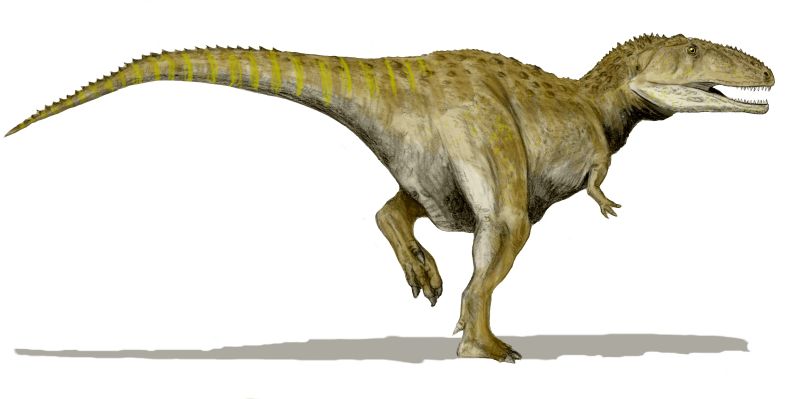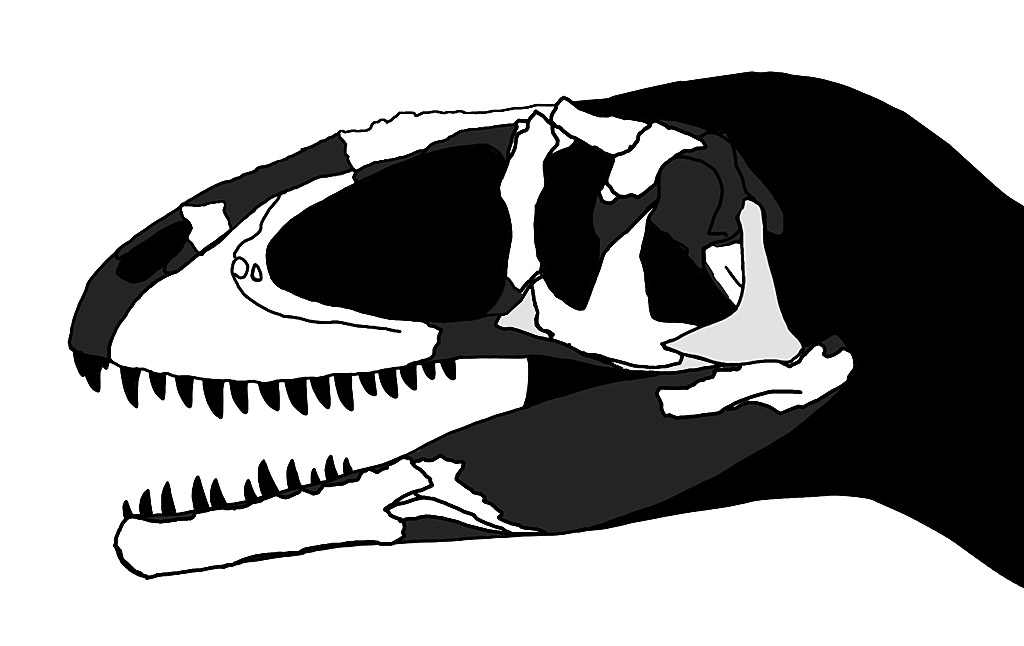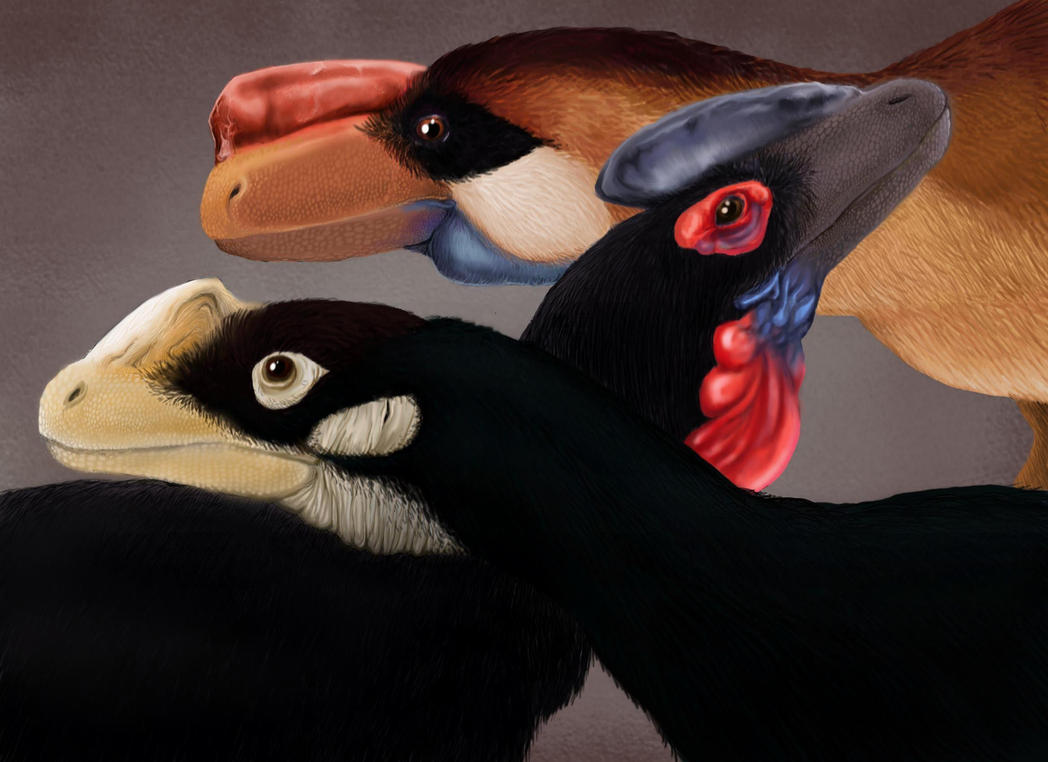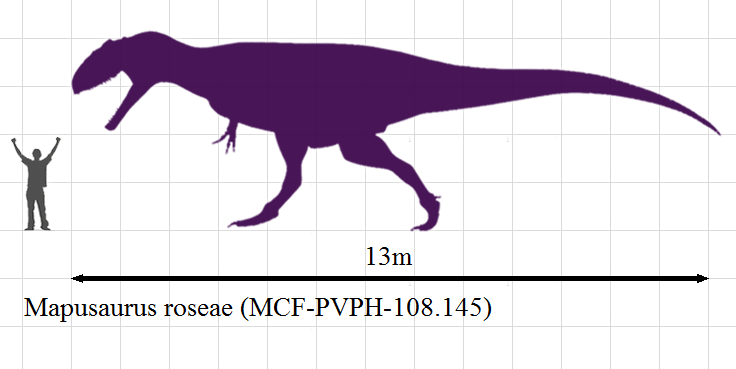gigadino96
Junior Member
  Vi ravviso, o luoghi ameni
Vi ravviso, o luoghi ameni
Posts: 226 
|
Post by gigadino96 on May 26, 2013 1:06:18 GMT 5
 Mapusaurus Mapusaurus was a giant South American meat-eating dinosaur with blade-like teeth for slicing off chunks of sauropod flesh. At over ten metres long Mapusaurus was similar in size to the closely related Giganotosaurus. Fossils from at least seven individuals of various ages were discovered in a bone bed in Argentina. This may suggest they worked in groups to take down the large sauropods of the time, such as the colossal Argentinosaurus, something a single Mapusaurus may not have been able to accomplish alone. Alternatively this group find may represent a simple predator-trap. Source: www.bbc.co.uk/nature/life/Mapusaurus
Name: Mapusaurus roseaeSize: ~ 12.5-13.6 meters long Mass: ~7-8.5 tons When: Late Cretaceous, Cenomanian-Turonian, 95-89 milion years ago Where: South America Classification: Animalia, Chordata, Reptilia, Saurischia, Carcharodontosauridae, Giganotosaurinae, Mapusaurus, Mapusaurus rosaeMapusaurus rosae is a kind of Theropod lived on Earth in the Upper Cretaceous, Cenomanian in, in what is now South America. It is considered as one of the largest known land predators, with the largest specimens comparable to Giganotosaurus in size. Unlike many of his relatives, has been known for some fairly complete skeletons, most of them belonging to young animals. Given its similarity to Giganotosaurus, the two animals were enclosed in the same subfamily, the Giganotosaurinae. An interesting aspect of this dinosaur is hunting in a group, in fact the first discovery which covered the remains of these animals comprised 7 skeletons, all belonging to youngs. From this it was assumed that this animal hunted in packs, though some paleontologist are against this hypothesis (http://theropoda.blogspot.it/2009/05/miti-...rne-sui_26.html). The his remains have come to light in the formation Huincul, layers of rock dating back to the Cenomanian. |
|
|
|
Post by creature386 on May 26, 2013 1:27:04 GMT 5
|
|
gigadino96
Junior Member
  Vi ravviso, o luoghi ameni
Vi ravviso, o luoghi ameni
Posts: 226 
|
Post by gigadino96 on Nov 6, 2014 14:11:43 GMT 5
|
|
Deleted
Deleted Member
Posts: 0
|
Post by Deleted on Nov 27, 2014 5:34:51 GMT 5
 MysteryMeat's skull reconstruction, credit goes to him. |
|
gigadino96
Junior Member
  Vi ravviso, o luoghi ameni
Vi ravviso, o luoghi ameni
Posts: 226 
|
Post by gigadino96 on Nov 27, 2014 21:45:22 GMT 5
 MysteryMeat's skull reconstruction, credit goes to him. He actually updated this recostruction, if I'm not wrong, but I cannot find the updated one. |
|
Deleted
Deleted Member
Posts: 0
|
Post by Deleted on Nov 28, 2014 0:30:02 GMT 5
 MysteryMeat's skull reconstruction, credit goes to him. He actually updated this recostruction, if I'm not wrong, but I cannot find the updated one. Ah, thanks for letting me know. I guess he would have posted it on CF, so I'll try to find it. |
|
|
|
Post by spinodontosaurus on Nov 28, 2014 8:18:01 GMT 5
|
|
Cross
Junior Member
  The biggest geek this side of the galaxy. Avatar is Dakotaraptor steini from Saurian.
The biggest geek this side of the galaxy. Avatar is Dakotaraptor steini from Saurian.
Posts: 266 
|
Post by Cross on May 28, 2015 11:15:39 GMT 5
Before I begin my own theses and such, I will start off my contribution to this thread by quoting paragraphs from the original paper that give some clues to the animal's size affinities, as the web is mislead by the misquoted 10.3m 3.3 ton figure. First, from the original paper (Coria and Currie 2006): " ABSTRACT
A new carcharodontosaurid theropod from the Huincul Formation (Aptian-
Cenomanian, Upper Cretaceous) of Neuquén Province, Argentina, is described.
Approximately the same size as
Giganotosaurus
carolinii
Coria & Salgado, 1995,
Mapusaurus
roseae
n. gen., n. sp." --
This is already counterindicative of an animal only 10m at maximum length, more likely 12.4 meters or 12.5 meters depending on which estimate is taken for MUCPv-ch1 (Hartman 2013, Coria and Salgado 1998). Coria and Bell (2013) gave a very conservative 11 meters during their paleopathological analysis. Other than the two popular specimens used to represent the larger individuals(MCF.PVPH-108.145 [the big pubis], and MCF.PVPH 108.202 [the big fibula]), there are also multiple isolated elements of rather large size as well. For example, MCF.PVPH 108.82, an 11th or 13th presacral cervicodorsal that measures 31cm across the diapophyses in pages 88-89 and fig. 14 of Coria and Currie (2006). (   |
|
|
|
Post by theropod on May 31, 2015 14:11:11 GMT 5
|
|
Cross
Junior Member
  The biggest geek this side of the galaxy. Avatar is Dakotaraptor steini from Saurian.
The biggest geek this side of the galaxy. Avatar is Dakotaraptor steini from Saurian.
Posts: 266 
|
Post by Cross on Aug 11, 2015 10:17:40 GMT 5
|
|
|
|
Post by dinosauria101 on May 10, 2019 20:40:42 GMT 5
|
|
|
|
Post by dinosauria101 on Jul 16, 2019 22:52:10 GMT 5
|
|
|
|
Post by Infinity Blade on Jan 17, 2021 1:10:08 GMT 5
The original description paper (already mentioned in one of the posts above) says something very interesting about the manus.
This is similar to what we see in Acrocanthosaurus (whose 1st and 2nd digits converged during flexion), and it appears the digits of Mapusaurus were also oriented to allow for grasping.
|
|














